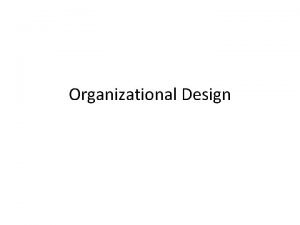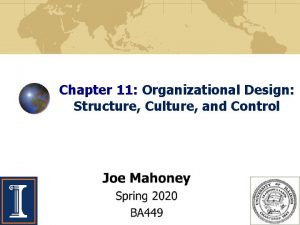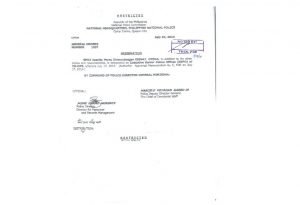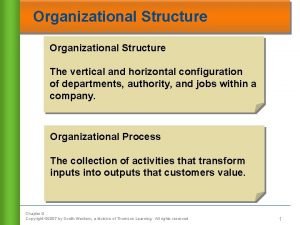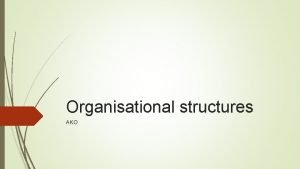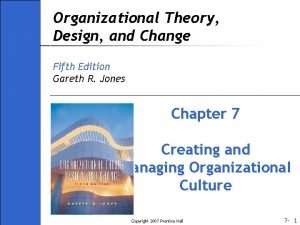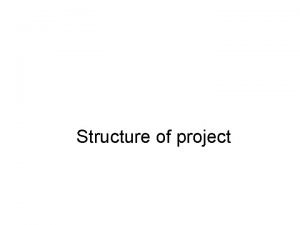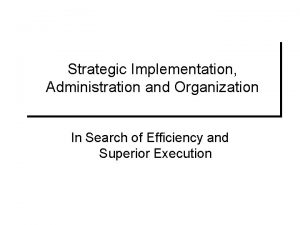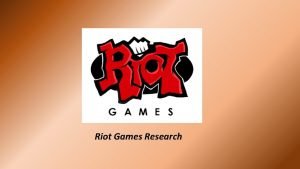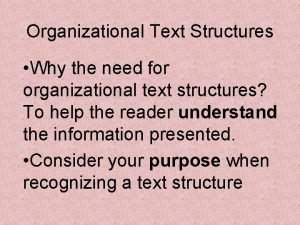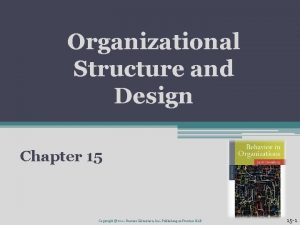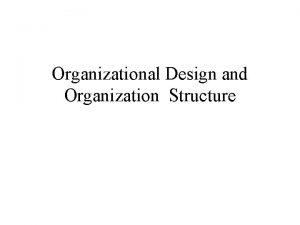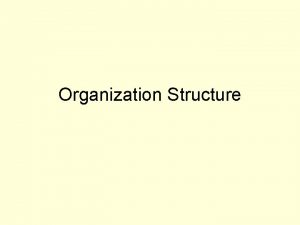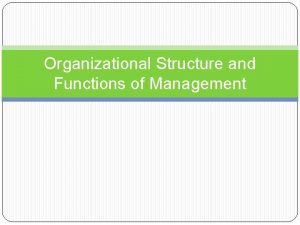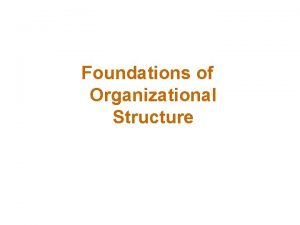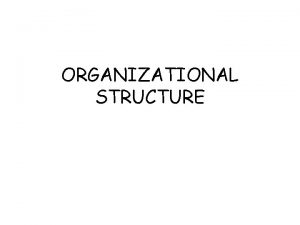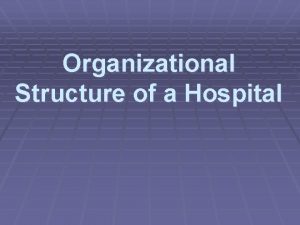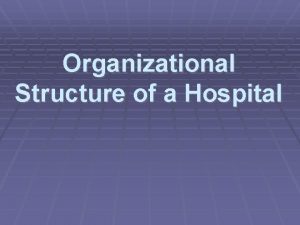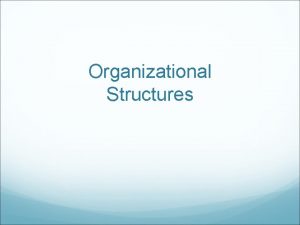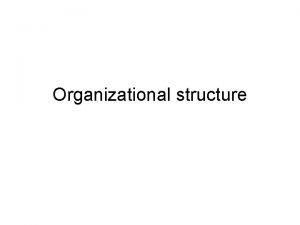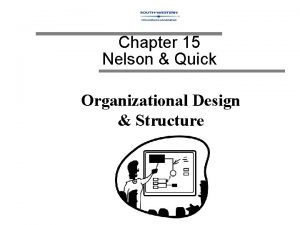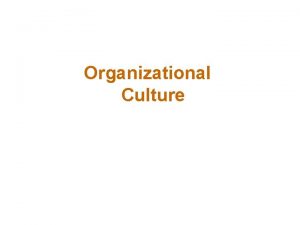Organizational Design and Organization Structure Organization An organization





























- Slides: 29


Organizational Design and Organization Structure

Organization “An organization is a pattern of relationship many interwoven, simultaneous relationship through which people, under the direction of managers, pursue their common goals”.

Organizational design “The determination of the organizational structure that is most appropriate for the strategy, people, technology, and tasks of the organization” “Planning is the process of org design” Design in an organization is much the same as for building, clothing and vehicles----it’s a plan. When a company’s leaders develop plans for how their company should function or would perform better, they undertake the business of organizational design. Good design takes inventory of all the tasks, functions and goals of a business, and then develops grouping or ordering of job positions, departments and individuals to best and most efficiently achieve those ends.

Organizational Structure “The way in which an organization activities are divided, organized, and coordinated” It is the skeleton of an organization. It is an expression of who is performing the various functions and tasks of a company and how these people relate to one another. It encompasses a list of the various job positions, titles and duties of a business, and the reporting structure or chain of command among them. “The Pattern of relationship”

Four Building Block • • Division of work Departmentalization Hierarchy Coordination

Contd. . • Division of work The breakdown of a complex task into components so that individual are responsible for a limited set of activities instead of the task as a whole for e. g. Adam smith pin e. g. • Departmentalization The grouping into departments of work activities that are similar and logical connected e. g. Banks, educational institution

Contd… • Hierarchy A pattern of multiple levels of an organizational structure, at the top of which is the senior – ranking manager (or manger) responsible for the operation of the entire organization; other, lower ranking managers are located down the various levels of the organization Tall and flat hierarchy for.

Contd… – Span of management control The number of subordinates reporting directly to a given manager. Also called span of control or span of management not too wide nor not too narrow – Chain of command The plan that specifies who reports to whom in an organization; such reporting lines are prominent features of any organization chart

Contd… • Coordination The integration of the activities of the separate parts of an organization to accomplish organization goals.

Differentiation and Integration • Differentiation “Differences in attitudes and working styles, arising naturally among members of different departments, that can complicate the coordination of an organization activities”

Type of differentiation • • Perspective Time orientation (long and short) Interpersonal style (fast and slow decision) Formality (Specific/General standard)

Integration “The term Lawrence and Lorsch use in place of coordination to designate the degree to which members of various departments work together in a unified manner” For e. g. Mkt dept and Sales dept

Downsizing “A version of organizational restructuring which results in decreasing the size of the organization and often results in a flatter organization convert to leaner, more flexible structures that can respond more readily to the pace of change in global markets”

Why Downsizing / Restructuring? Ø Increased Competition Ø Advent of a new and more efficient technology Ø Emergence of new markets Ø Emergence of new classes of consumers Ø Demographic changes Ø Business cycles Ø Ø Ø Ø Change in fiscal and government policies Liberalization, Privatization, and Globalization (LPG) Cost Reduction Divestment Improving profits Core Competencies Enhancing shareholder value Incompatible company objectives

Types of Organizational Structures • • • Functional Product Geography Customer Matrix

Functional A Form of departmentalization in which individuals engaged in one functional activity, such as marketing or finance etc are grouped into one unit

Product The organization of a company into division that bring together those involved with a certain type of product

Geographic The organization of a company into division that bring together those involved with a certain type of market

Matrix An organization structure in which each employee reports to both a functional or division manager and to project or group manager

Informal Organization The undocumented and officially unrecognized relationships between members of an organization that inevitably emerge out of the personal and groups needs of employees

Virtual Organization “is a temporary network of independent companies suppliers, customers, even erstwhile rivals linked by information technology to share skills, costs, and access to one another’s markets. It will have neither central office nor organization chart. It will have no hierarchy , no vertical integration”

Power The ability to exert influence; that is, the ability to change the attitudes or behavior of individuals or groups For e. g. Stakeholders

Sources of power • • • Reward power Coercive power Legitimate power Expert power Referent power

Reward power Power derived from the fact that one person, know as a influencer, has the ability to reward another person, know as an influencee, for carrying out the orders, which may be expressed or implied

Coercive power The negative side of reward power, based on the influencer’s ability to punish the influencee

Legitimate power Power that exists when a subordinate or influencee acknowledges the influencer has a “right” or is lawfully entitled to exert influence within certain bounds; also called formal authority

Expert Power based on the belief or understanding that the influencer has specific knowledge or relevant expertise that the influencee does not

Referent power Power based on the desire of the infulencee to be like or identify with the influencer
 Organizational structure and design
Organizational structure and design Organizational design: structure, culture, and control
Organizational design: structure, culture, and control Forces reshaping organizations
Forces reshaping organizations Pnp organizational structure 2021 with names
Pnp organizational structure 2021 with names Coca cola departmentalization
Coca cola departmentalization Difference between tall and flat organizational structure
Difference between tall and flat organizational structure Johnson and johnson organizational structure
Johnson and johnson organizational structure Sbu m-form structure
Sbu m-form structure School administrative structure
School administrative structure Strengths and weaknesses of flat organizational structure
Strengths and weaknesses of flat organizational structure Pros and cons of tall organizational structure
Pros and cons of tall organizational structure Organizational theory design and change
Organizational theory design and change Simple organizational design strength and weaknesses
Simple organizational design strength and weaknesses Well design feasibility
Well design feasibility Political feasibility
Political feasibility What is an organization
What is an organization Pure project structure
Pure project structure Unitary form organizational structure
Unitary form organizational structure Shamrock organization
Shamrock organization Steve snow riot games
Steve snow riot games Organizational structure of ethiopian airlines
Organizational structure of ethiopian airlines Projectized organizational structure
Projectized organizational structure Noor afalla
Noor afalla Composition of school governing council
Composition of school governing council Bb organogram
Bb organogram Concept definition text structure examples
Concept definition text structure examples Housekeeping organizational structure
Housekeeping organizational structure Team based structure
Team based structure Hollow organizational structure
Hollow organizational structure Definition of organizational chart
Definition of organizational chart
